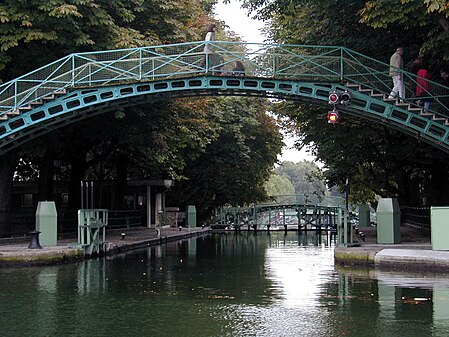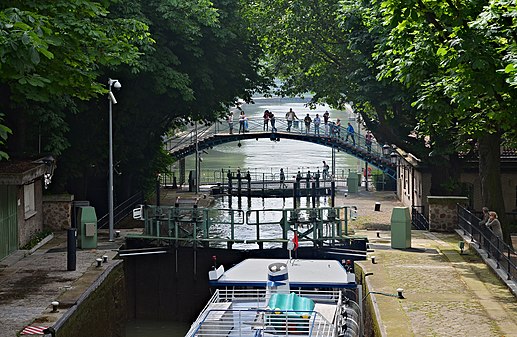Canal Saint-Martin
| Canal Saint-Martin | |
|---|---|
 Plan of the Canal Saint-Martin | |
| Specifications | |
| Length | 4.6 kilometres (2.9 mi) |
| Maximum boat length | 40.70 m (133.5 ft) |
| Maximum boat beam | 7.70 m (25.3 ft) |
| Locks | 9 |
| History | |
| Current owner | Ville de Paris |
| Date approved | 1802 |
| Date completed | 1825 |
| Geography | |
| Start point | Paris Place de Stalingrad (Bassin de la Villette, Canal de l'Ourcq) |
| End point | Paris Quai de la Râpée (entrance lock from Seine) |
| Beginning coordinates | 48°53′32″N 2°23′10″E / 48.8923°N 2.3862°E |
| Ending coordinates | 48°50′48″N 2°21′57″E / 48.8468°N 2.3657°E |
| Connects to | Canal de l'Ourcq and River Seine |
The Canal Saint-Martin (French pronunciation: [kanal sɛ̃ maʁtɛ̃]) is a 4.6 km (2.86 mi) long canal in Paris, connecting the Canal de l'Ourcq to the river Seine. Nearly half its length (2,069 metres (2,263 yd)), between the Rue du Faubourg du Temple and the Place de la Bastille, was covered in the mid-19th century to create wide boulevards and public spaces on the surface.[1] The canal is drained and cleaned every 10–15 years, and it is always a source of fascination for Parisians to discover curiosities and even some treasures among the hundreds of tons of discarded objects.
History
The canal was also used to supply Paris with grain, building materials and other goods, carried on canal boats. Two ports were created on the canal in Paris to unload the boats:
By the 1960s, traffic had dwindled to a trickle and the canal narrowly escaped being filled in and paved over for a highway.
Route
The entrance to the canal from the vast terminal basin (Bassin de la Villette) of the
Tourism
Today, the canal is a popular destination for Parisians and tourists. Some take cruises on the canal in passenger boats. Others watch the barges and other boats navigate the series of locks and pass under the attractive cast-iron footbridges. There are many popular restaurants and bars along the open part of the canal, which is also popular with students.
Métro stations
The canal can be accessed from the following
In popular culture
Art
The canal inspired painters such as Alfred Sisley (1839-1899). In the present day, many intricate works of graffiti are visible along the canal, and there is a large multimedia art space on its banks at the former municipal undertakers building at 104 rue d'Aubervilliers ('104').
Film and television
- The canal was the setting in part for Jean Vigo's film L'Atalante in 1934.
- The canal is shown in the 1938 film Hôtel du Nord, directed by Marcel Carné.[2]
- In Les Malheurs d'Alfred (1972), Pierre Richard and Anny Dupereymeet each other at the beginning of the film, thinking of committing suicide in the canal.
- The French police series PJ uses an external shot of a building at 52 rue Bichat, located next to the canal, as the frontage of the police station. Cars were often shown exiting the building and the canal and adjacent neighbourhood were used as backdrops for scenes.
- The canal appears in skipping stones at the locks of the canal.[3]
- The canal was used as an escape route for Ethan Hunt and his team in the 2018 film Mission: Impossible – Fallout.
- The Canal was used by John Wick as a route to get closer to Saint-Eustache in the 2023 film John Wick: Chapter 4.
Music
- Les mômes de la cloche", written by Vincent Scottoand Decaye, music by Médinger, in 1936.
- Courteeners song "The Dilettante" mentions the canal and talks of the pleasant atmosphere surrounding it.
Literature
- Georges Simenon's novel Maigret and the Headless Corpse (Maigret et le corps sans tête) is set in and around the canal.
Gallery
-
Canal St. Martin at Square Frédérick-Lemaître
-
The Boulevard Jules-Ferry, which covers the lower end of the canal
-
A typical iron bridge over the canal
-
The locks of the Récollets
References
- ISBN 978-1-846230-14-1.
- ^ However, the film was shot in the studios of Boulogne-Billancourt where the scenery of the canal was rebuilt by Alexandre Trauner.
- ^ The Guardian review, 15 August 2001
External links
- Paris - Canal de l'Ourcq, Canal Saint-Denis and Canal Saint-Martin maps and information on places, ports and moorings on the canals, by the author of Inland Waterways of France, Imray
- Navigation details for 80 French rivers and canals (French waterways website section)
- Blog of the Canal Saint-Martin quarter Archived 2014-03-12 at the Wayback Machine (in French)
- Canal Saint-Martin map Archived 2015-06-10 at the Wayback Machine (in French)
- The sunken treasures of a Paris canal





